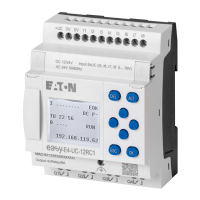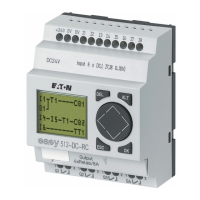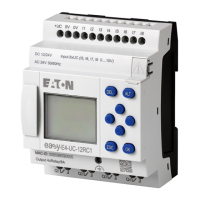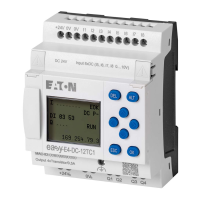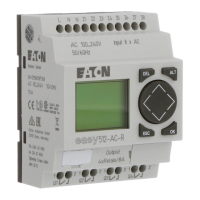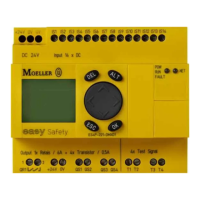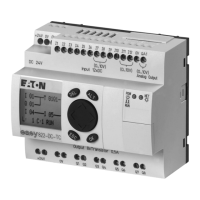
Do you have a question about the Eaton easy800 and is the answer not in the manual?
| Supply voltage | 24 VDC, 100-240 VAC |
|---|---|
| Programming Software | EASY-SOFT |
| Display | LCD |
| Protection class | IP20 |
| Number of Digital Inputs | 8 |
| Communication Ports | RS-485 |
| Operating temperature | -25°C to +55°C |
Details changes and updates across different manual editions.
Defines the intended audience and required qualifications for using the manual.
States limitations of liability and disclaimers for manual usage and program examples.
Explains common terms and abbreviations used for easy800 devices and systems.
Explains the meaning of symbols used for danger, warning, caution, and tips.
Specifies the correct application and safety guidelines for the easy800 device.
Summarizes the core functionalities including logic, timing, arithmetic, and networking.
Describes different versions of easy800 devices and their features.
Guides on navigating menus and entering values using the device's keypad.
Explains physical installation methods like top-hat rail or screw fixing.
Details attaching expansion units to the easy800 standard device.
Lists required tools and cable cross-section specifications for connections.
Provides instructions and safety precautions for connecting the power supply.
Guides on connecting digital and analog inputs, including specific types.
Explains wiring for relay and transistor outputs, including parallel connections.
Covers connecting the easyNet network, including cable routing and topology.
Details serial interface connections for PC, modem, and MFD communication.
Explains the process of connecting SWD stations and components.
Outlines pre-startup checks and the device's power-on behavior.
Guides on selecting the user interface language.
Explains the meaning of various LEDs for status indication.
Describes interpreting the device's status display for inputs, outputs, and system information.
Explains the device's processing of circuit diagrams and function blocks.
Details configuring SWD inputs as outputs.
Explains operating modes like RUN, STOP, and BUSY.
Provides a step-by-step guide to creating a basic circuit diagram.
Guides on setting parameters for analog expansion units.
Covers configuring and commissioning the easyNet network.
Details bringing the SmartWire-DT system online.
Explains navigation and display of the circuit diagram.
Lists the components that make up an easy800 program.
Details transferring programs from PC to easy800-SWD.
Describes basic circuit diagram components like coils, contacts, and function blocks.
Guides on wiring contacts, coils, and their modifications.
Explains loading and saving programs using a memory card.
Introduces principles of using function blocks in circuit diagrams and editors.
Compares analog values against setpoints.
Performs basic arithmetic operations.
Compares contiguous data blocks or marker ranges.
Transfers values between marker ranges.
Combines values using logical operations.
Counts pulses with programmable direction and limits.
Measures frequency using digital inputs.
Enables high-speed up/down counting of edges.
Counts incremental values based on edge changes.
Compares variables or constants.
Outputs text and variables on the device display.
Stores values like setpoints for function blocks.
Implements PID control loops.
Smooths noisy analog input signals.
Retrieves 32-bit values from the easyNet network.
Provides weekly time switch functionality.
Details the function block for year-based time switch operations.
Branches program execution based on conditions.
Serves as a jump target for conditional jumps.
Converts values between different ranges.
Resets markers and outputs to zero.
Selects a value from eight inputs.
Converts values between BCD and binary formats.
Records operating hours of events or states.
Generates defined numbers of pulses or pulse sequences.
Transfers 32-bit operands to the easyNet network.
Modulates the mark-to-space ratio of square wave signals.
Places date and time onto the network.
Sends texts or data via the serial interface.
Shifts bits or marker double words.
Defines a fixed cycle time for processing.
Provides timing relay operations with adjustable delay times.
Creates and reads table entries in double words.
Outputs values within defined limits.
Example demonstrating the use of timing relay and counter blocks.
Introduces the CAN-based easyNet network and its capabilities.
Explains how NET stations operate with or without their own programs.
Details NET parameters like station ID, baud rate, and bus delay time.
Discusses error detection capabilities and message error rates in easyNet.
Covers project, target, and actual configurations for SWD stations.
Details input/output data and operands for SWD stations.
Explains device parameters like STOP on SWD error and station compatibility.
Addresses common errors on the SWD line and their troubleshooting.
Explains setting up, activating, and managing device passwords.
Covers system settings including input delay, pushbuttons, startup behavior, and card mode.
Guides on changing the device's menu language.
Details accessing the configurator for NET, LINK, and ETHERNET-GW.
Explains how to set the device's date, time, and daylight saving parameters.
Explains the device's sequential processing of circuit diagrams and function blocks.
Describes how the device monitors cycle completion time and handles faults.
Offers essential points for designing circuit diagrams.
Addresses special considerations for high-speed counters and DC/FT blocks.
Details timing characteristics of inputs/outputs, including delay times.
Explains expanding the easy800 standard with easyLink and communication units.
Covers baud rate dependent timeout monitoring of serial communication.
Explains how to view device information for service tasks.
Guides on installing new operating system versions for easy800-SWD.
Explains how easy800 devices output operating state via diagnostic contacts.
Mentions group alarms for expansion units.
Details group alarms for SWD line errors and diagnostic bits.
Describes scanning transistor outputs for short-circuits or overloads.
Lists LCD messages, explanations, and remedies.
Discusses common circuit diagram creation issues and solutions.
Lists events and their explanations or remedies, such as display problems.
Addresses SWD line errors and SWD-LED behavior.
Covers NET issues, including LED status and troubleshooting.
Lists product standards, approvals, and certifications.
Provides physical dimensions of the devices.
Covers technical specifications including ambient conditions and electrical data.
Shows compatible combinations of devices and expansion units.
Lists compatible SWD station types and replacements.
Illustrates the menu hierarchy for device settings.
Provides an alphabetical list of function blocks with references.
Lists usable contacts and coils for standard circuit diagrams.
Details memory requirements for rungs, function blocks, and constants.
Lists ASCII characters for start/end sequences.
Shows character sets for text display functions.
